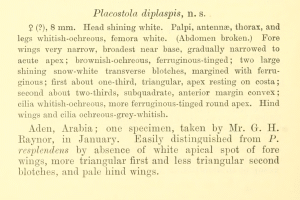

 +10Kontinente:EUAS
+10Kontinente:EUAS3. Biologie
3.1. Nahrung der Raupe
Kasy (1973: 265) vermerkte in seiner Gattungs-Revision: "Zwei der untersuchten Ex. aus S-Indien tragen einen Vermerk, nach dem die Raupe an Ficus glomerata gefunden wurde und an dieser Pflanze möglicherweise räuberisch von Schildläusen der Gattung Pulvinaria gelebt hat."
Heckford (2003) hatte drei Raupen an Granatapfel aus einem Londoner Supermarkt erhalten und berichtet über seine Zuchtergebnisse, die nahe legen, dass Insekten als Nahrung für die Raupe zumindest nicht zwingend sind: "The three larvae were in slight silken tubes in the calyx of the pomegranates. I purchased several on each occasion and some, but not all, had apparently dead white scale insects within the calyx; I cannot recall whether there were any with the larvae. I did not provide the larvae with them, as I removed them from the calyx and gave the larvae parts of it, which meant subsequently purchasing a number of the fruit for this purpose as the calyx tends either to go mouldy or dessicate quite quickly. The larvae spun slight, whitish, semi-transparent silken tubes either in crevices in the base of the calyx or amongst the dried stamens on the inside of the calyx, and fed both on the flesh of the calyx and, apparently, on the dried stamens, but did not enter the fruit. The larva that produced the moth fed very slowly from the date of purchase until 23 February 2001 when it spun a cocoon. I do not know whether this lengthy feeding period is usual, whether it would have been quicker in natural conditions, or whether scale insects are part of the normal diet, without which the larva grows more slowly. Although it did grow in size, when it pupated it did not seem significantly larger than when the pomegranate was bought. In any event, it is clear that scale insects were not necessary for the larva to complete its growth, and the moth is not undersize".
4. Weitere Informationen
4.1. Andere Kombinationen
- Placostola diplaspis Meyrick, 1887 [Originalkombination]
4.2. Synonyme
- Stathmopoda ovigera Meyrick, 1913 [synonymisiert durch Kasy (1973: 264-265)]
4.3. Faunistik
Locus typicus ist "Aden, Arabia", also die heutige Großstadt im Jemen. Locus typicus des Synonyms S. ovigera ist "Puttalam, Ceylon", heute Sri Lanka.
Kasy (1973: 265) fasste zur Verbreitung zusammen: "Bisher bekannt aus S-Arabien, Iran, NW-Pakistan, S-Indien, Ceylon."
Heckford (2003) konnte die Art in Form verschleppter Raupen in Plymouth finden: "On 25 March 2001 I bred a female Stathmopoda diplaspis (Meyrick) from a larva found in the calyx of a pomegranate (Punica granatum), stated origin Iran, purchased at a superstore at Plymouth, Devon (V.C.3) on 8 December 2000. I cannot trace that the species has previously been recorded from the British Isles, nor that the larva has been fully described. Indeed the life history appears to be poorly known and may be based solely on two bred specimens. Although I reared only one moth, this is not an isolated record. There were two identical larvae in the pomegranate that I bought, but the other died. A year before, on 11 December 1999, I had found a similar larva in a pomegranate, also from Iran, in the same superstore. It is very unlikely that these are the only larvae to have been accidentally imported to this country."
Er fasste neu zusammen: "The species is rather widely distributed in central and south-west Asia: Saudia Arabia; Iran; Afghanistan; Pakistan; India and Sri Lanka (Kasy, 1973: 263-265); Tajikistan (Falkovitsh & Sinev, 1988: 109); Afghanistan (Dr S. Yu Sinev pers. comm.) and Thailand (specimens in the BMNH)." "Saudia Arabia" dürfte dabei durch eine Fehlinterpretation von "S Arabia" zustande gekommen sein und ist zu streichen - der Fundort Aden liegt im Jemen.
(Autor: Erwin Rennwald)
4.4. Typenmaterial
Kasy (1973: 263-265) berichtet:
Placostola diplaspis Meyrick: Locus typicus: S-Arabien: Aden. Holotypus (Monotypus) ♀: "Holotype" "Aden, Arabia, GHR. 15. 1. 80" "Meyrick Coll. B.M. 1938-290" "Abdomen missing" "diplaspis Meyr." "Holotype ♀, Placostola diplaspis Meyr. teste K. Sattler, 1971" (BM)."
und
Stathmopoda ovigera Meyrick: Locus typicus: Ceylon: Puttalam. Lectotypus ♂ (hier festgelegt): "Lectotype" "Puttalam, Ceylon. Pole. 10. 04." "Stathmopoda ovigera Meyr., 5/1; E. Meyrick det., in Meyrick, Coll." "Meyrick Coll. B.M. 1938-290", "ovigera Meyr." "lectotypus ♂, Stathmopoda ovigera Meyr., teste F. Kasy, 1968". GU-15071-BM (BM). Syn. nov."
4.5. Literatur
- Erstbeschreibung: Meyrick, E. (1887) XIII. Descriptions of some exotic Micro-Lepidoptera. — Transactions of the Entomological Society of London, 1887: 269-280. [Digitalisat auf biodiversitylibrary.org]
- Heckford, R.J. (2003): Stathmopoda diplaspis (Meyrick, 1887) (Lepidoptera: Oecophoridae) an adventive species new to the British Isles. — Entomologist's Gazette, 54(1): 1-4.
- Kasy, F. (1973): Beitrag zur Kenntnis der Familie Stathmopodidae Meyrick, 1913 (Lepidoptera, Gelechioidea). — Tijdschrift voor Entomologie 116 (13): 227—299. [Digitalisat auf archive.org]












